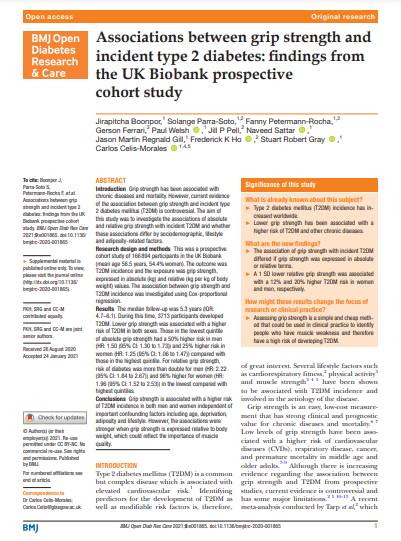Associations between grip strength and incident type 2 diabetes: findings from the UK Biobank prospective cohort study

Fecha
2021-08-29Autor
Boonpor, Jirapitcha
Parra-Soto, Solange
Petermann-Rocha, Fanny
Ferrari, Gerson
Welsh, Paul
Pell, Jill P.
Sattar, Naveed
Gill, Jason Martin Regnald
Ho, Frederick K.
Gray, Stuart Robert
Celis-Morales, Carlos [Univ Mayor, Ctr Exercise Physiol Res CIFE, Chile]
Ubicación geográfica
Notas
HERRAMIENTAS
Acceda a títulos restringidos
¿Cómo descargar?Resumen
Introduction Grip strength has been associated with chronic diseases and mortality. However, current evidence of the association between grip strength and incident type 2 diabetes mellitus (T2DM) is controversial. The aim of this study was to investigate the associations of absolute and relative grip strength with incident T2DM and whether these associations differ by sociodemographic, lifestyle and adiposity-related factors. Research design and methods This was a prospective cohort study of 166 894 participants in the UK Biobank (mean age 56.5 years, 54.4% women). The outcome was T2DM incidence and the exposure was grip strength, expressed in absolute (kg) and relative (kg per kg of body weight) values. The association between grip strength and T2DM incidence was investigated using Cox-proportional regression. Results The median follow-up was 5.3 years (IQR: 4.7-6.1). During this time, 3713 participants developed T2DM. Lower grip strength was associated with a higher risk of T2DM in both sexes. Those in the lowest quintile of absolute grip strength had a 50% higher risk in men (HR: 1.50 (95% CI: 1.30 to 1.73)) and 25% higher risk in women (HR: 1.25 (95% CI: 1.06 to 1.47)) compared with those in the highest quintile. For relative grip strength, risk of diabetes was more than double for men (HR: 2.22 (95% CI: 1.84 to 2.67)) and 96% higher for women (HR: 1.96 (95% CI: 1.52 to 2.53)) in the lowest compared with highest quintiles. Conclusions Grip strength is associated with a higher risk of T2DM incidence in both men and women independent of important confounding factors including age, deprivation, adiposity and lifestyle. However, the associations were stronger when grip strength is expressed relative to body weight, which could reflect the importance of muscle quality.
URI
https://repositorio.umayor.cl/xmlui/handle/sibum/9081https://www.ncbi.nlm.nih.gov/pmc/articles/PMC8344322/pdf/bmjdrc-2020-001865.pdf
https://doi.org/10.1136%2Fbmjdrc-2020-001865
https://eprints.gla.ac.uk/233194/1/233194.pdf
https://drc-bmj-com.bibliotecadigital.umayor.cl:2443/sites/default/themes/bmjj/img/icon-pdf.png
Coleccion/es a la/s que pertenece:
Si usted es autor(a) de este documento y NO desea que su publicación tenga acceso público en este repositorio, por favor complete el formulario aquí.